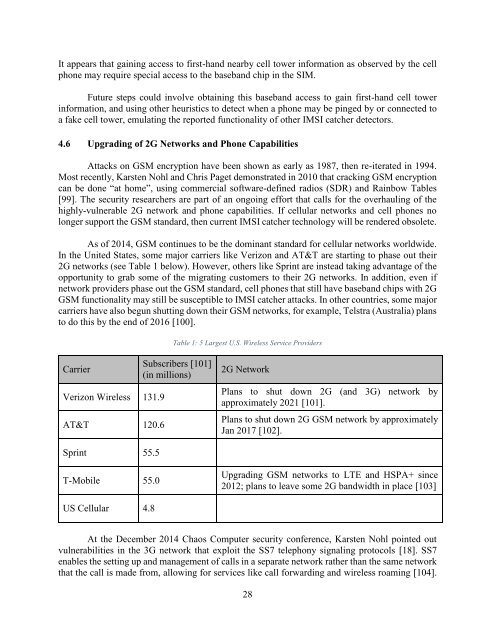IMSI Catchers and Mobile Security
EAS499Honors-IMSICatchersandMobileSecurity-V18F-1
EAS499Honors-IMSICatchersandMobileSecurity-V18F-1
Create successful ePaper yourself
Turn your PDF publications into a flip-book with our unique Google optimized e-Paper software.
It appears that gaining access to first-h<strong>and</strong> nearby cell tower information as observed by the cell<br />
phone may require special access to the baseb<strong>and</strong> chip in the SIM.<br />
Future steps could involve obtaining this baseb<strong>and</strong> access to gain first-h<strong>and</strong> cell tower<br />
information, <strong>and</strong> using other heuristics to detect when a phone may be pinged by or connected to<br />
a fake cell tower, emulating the reported functionality of other <strong>IMSI</strong> catcher detectors.<br />
4.6 Upgrading of 2G Networks <strong>and</strong> Phone Capabilities<br />
Attacks on GSM encryption have been shown as early as 1987, then re-iterated in 1994.<br />
Most recently, Karsten Nohl <strong>and</strong> Chris Paget demonstrated in 2010 that cracking GSM encryption<br />
can be done “at home”, using commercial software-defined radios (SDR) <strong>and</strong> Rainbow Tables<br />
[99]. The security researchers are part of an ongoing effort that calls for the overhauling of the<br />
highly-vulnerable 2G network <strong>and</strong> phone capabilities. If cellular networks <strong>and</strong> cell phones no<br />
longer support the GSM st<strong>and</strong>ard, then current <strong>IMSI</strong> catcher technology will be rendered obsolete.<br />
As of 2014, GSM continues to be the dominant st<strong>and</strong>ard for cellular networks worldwide.<br />
In the United States, some major carriers like Verizon <strong>and</strong> AT&T are starting to phase out their<br />
2G networks (see Table 1 below). However, others like Sprint are instead taking advantage of the<br />
opportunity to grab some of the migrating customers to their 2G networks. In addition, even if<br />
network providers phase out the GSM st<strong>and</strong>ard, cell phones that still have baseb<strong>and</strong> chips with 2G<br />
GSM functionality may still be susceptible to <strong>IMSI</strong> catcher attacks. In other countries, some major<br />
carriers have also begun shutting down their GSM networks, for example, Telstra (Australia) plans<br />
to do this by the end of 2016 [100].<br />
Table 1: 5 Largest U.S. Wireless Service Providers<br />
Carrier<br />
Verizon Wireless 131.9<br />
AT&T 120.6<br />
Subscribers [101]<br />
(in millions)<br />
2G Network<br />
Plans to shut down 2G (<strong>and</strong> 3G) network by<br />
approximately 2021 [101].<br />
Plans to shut down 2G GSM network by approximately<br />
Jan 2017 [102].<br />
Sprint 55.5<br />
T-<strong>Mobile</strong> 55.0<br />
Upgrading GSM networks to LTE <strong>and</strong> HSPA+ since<br />
2012; plans to leave some 2G b<strong>and</strong>width in place [103]<br />
US Cellular 4.8<br />
At the December 2014 Chaos Computer security conference, Karsten Nohl pointed out<br />
vulnerabilities in the 3G network that exploit the SS7 telephony signaling protocols [18]. SS7<br />
enables the setting up <strong>and</strong> management of calls in a separate network rather than the same network<br />
that the call is made from, allowing for services like call forwarding <strong>and</strong> wireless roaming [104].<br />
28



